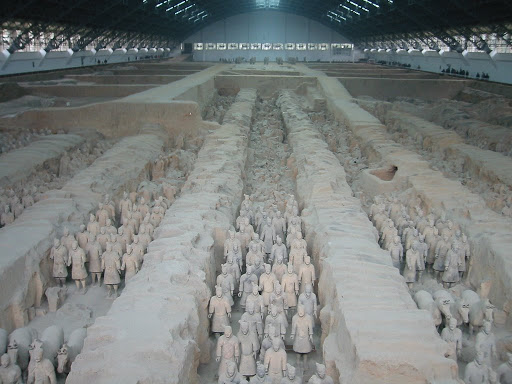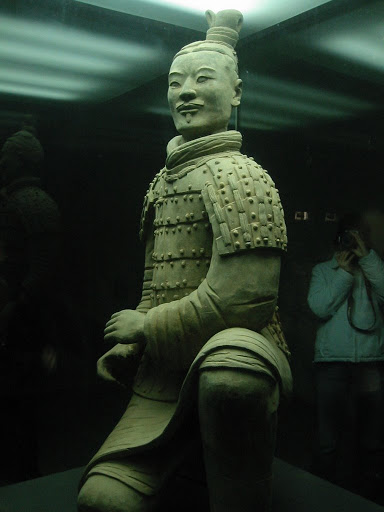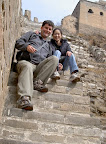 Our minibus stopped at two other hotels, further from the local CITS but much more convenient for the guests, to pick up another ten tourists, including an old Finnish gay man and his younger Thai partner and a couple of Swiss and Italians. On the way our coach driver got into a verbal argument with some men from a wedding party over who had the right to block the hotel driveway. We then drove off to the nearest of the day's destinations, the Big Wild Goose Pagoda.
Our minibus stopped at two other hotels, further from the local CITS but much more convenient for the guests, to pick up another ten tourists, including an old Finnish gay man and his younger Thai partner and a couple of Swiss and Italians. On the way our coach driver got into a verbal argument with some men from a wedding party over who had the right to block the hotel driveway. We then drove off to the nearest of the day's destinations, the Big Wild Goose Pagoda.The pagoda was built to house the precious Buddhist artifacts and scrolls brought back from India by the monk Xuanzang. Xuanzang's pilgrimage formed the basis of the story Journey into the West, better known by the Japanese television series Monkey!
While the central 64 metre pagoda is impressive (we were too lazy to climb it), also worth seeing is the colourful jade wall representation of Sakyamuni's (Buddha's) life. The story has obviously undergone some modifications over the years, with Sakyamuni now depicted as having special powers as a baby and a halo through his life - very much like the story of Christ.
The wooden depictions of Xuanzang's journey are also worth a look, though I could not see any monkeys flying around on clouds.
The following destination was the obligatory shopping stop, ostensibly to learn how the warriors were constructed (head and hands moulded separately from the body, which was made on a pottery wheel). Really, it was just a shallow attempt to get us to buy various sized repoductions and furniture.
 Next stop was the Banpo Ancient Village. This is the site of excavations of a neolithic village from 6000 years ago. The Banpo society was apparently matriarchal and according to our guide there was no central management structure and everyone worked for the common good of the village - conveniently communist methinks.
Next stop was the Banpo Ancient Village. This is the site of excavations of a neolithic village from 6000 years ago. The Banpo society was apparently matriarchal and according to our guide there was no central management structure and everyone worked for the common good of the village - conveniently communist methinks.From the shape of the ground indentations the Banpo people were neolithic smurfs. Not certain about their skin colour being blue, but they did live in mushrooms. Or so their wood and adobe houses appeared.
Excavations show the skeletons of adults, sometimes buried together in communual cemetary grounds. The babies were placed in clay pots kept in the houses of the mothers, who would continue to "look after" their offspring. Descendants were also known to chop off a couple of their digits to be buried with their parents. Don't remember ever seeing the smurfs doing that.
The lunch was also vary much a tourist trap location, though at least B got to eat some rice (short grain - the Cantonese seem to use long grain). The food was okay and at least we didn't go through our normal practice of searching the whole city for food.
Each time the coach set off we napped. After late nights and early mornings we were both exhausted. A couple of good things about the tour was that we were driven around and could relax from planning and thinking.
 Finally, we made it to the Terracotta Warriors, braving the hawkers as we made our way up from the carpark to the excavation site. There was a lot of redevelopment going on, with men jackhammering away and women using picks. Posters lined the sides of the path, one stating:
Finally, we made it to the Terracotta Warriors, braving the hawkers as we made our way up from the carpark to the excavation site. There was a lot of redevelopment going on, with men jackhammering away and women using picks. Posters lined the sides of the path, one stating:Qin Wind, Qin Smelody, Qin Culture
Maybe they also ate cabbages for lunch.
The warriors were as impressive as the hype suggested. There are three excavations. The first pit is in the aircraft hanger like building. This contains the reconstructed warriors in formation, plus others in a partly reconstructed state. Much of the location remains unexcavated in order to retain the colouration on the buried warriors.
The seconds pit houses the general staff and a chariot. Most of the third and final pit is unexcavated, but a few figures have been reconstructed, including a couple of archers, a general and a lower ranking officer. These you can see up close and the level of detail is incredible, down to the tread of their shoes.
 The tour gave us enough time at the warriors to see all we wanted to, then it was back to our hotels. We were tempted to request to be dropped off in the centre of Xian and explore it further, but both of us, me especially, were tired and want to call it an early night. So we found a dumpling restaurant recommended by the Lonely Planet and located across from the hotel. The difficult bit was in crossing the road, dodging the cars. Scary.
The tour gave us enough time at the warriors to see all we wanted to, then it was back to our hotels. We were tempted to request to be dropped off in the centre of Xian and explore it further, but both of us, me especially, were tired and want to call it an early night. So we found a dumpling restaurant recommended by the Lonely Planet and located across from the hotel. The difficult bit was in crossing the road, dodging the cars. Scary.I would like to have seen more of Xian, walked the city walls and explored the Muslim Quarter. It seems a fascinating place, though sometimes the streetscapes reminded me of Beijing. Tomorrow we are off very early to Chengdu and Leshan. Time to get an early night.


